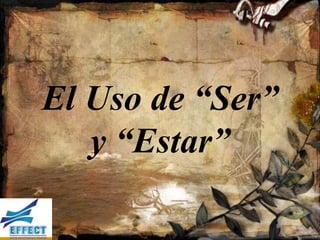
Ser y estar
- 1. El Uso de “Ser” y “Estar”
- 2. En español “ser” y “estar” son verbos irregulares en Presente de Indicativo: Ser Estar yo soy estoy tú eres estás él/ella/Usd es está nosotros/as somos estamos vosotros/as sois estáis ellos/ellas/Usds son están
- 3. En Pretérito Indefinido (Perfecto Simple) también mantienen su irregularidad: Ser Estar yo fui estuve tú fuiste estuviste él/ella/Usd fue estuvo nosotros/as fuimos estuvimos vosotros/as fuisteis estuvisteis ellos/ellas/Usds fueron estuvieron
- 4. Pero en Pretérito Imperfecto sólo “estar” pierde su irregularidad: Ser Estar yo era estaba tú eras estabas él/ella/Usd era estaba nosotros/as éramos estábamos vosotros/as erais estabais ellos/ellas/Usds eran estaban
- 5. Hablando del Futuro ellos representan sus formas con la ayuda de las terminaciones adecuadas de este tiempo: yo -é tú - ás él/ella/Usd -á nosotros/as - emos vosotros/as - áis ellos/ellas/Usds - án
- 6. El participio de estos verbos son regulares: sido, estado. El modo subjuntivo de “ser” y “estar” se forma diferente: - en Presente de subjuntivo sólo “estar” cambia sus terminaciones, mientras “ser” es irregular: sea, seas, sea, seamos, seáis, sean; - en Pretérito Imperfecto de subjuntivo ambos son irregulares.
- 7. El verbo “Ser” usamos para: • identificarse asi mismo: Hola, Maria. Soy Marta. • identificar a una persona o cosa: Este es Antonio, el amigo del que te hablé. • identificar la nacionalidad/ origen: ¿Eres tú canadiense? • describir personas y cosas objetivamente: Yo creo que la exposición será interesante. • informar sobre el material: Esta mesa es de cristal.
- 8. El verbo “Ser” usamos para: • localizar algo en el tiempo: Mañana será la inauguración. • informar de dónde ocurre un suceso: ¿Dónde es la fiesta? • justificarse (es que...): ¿Venís? – No podemos, es que hemos quedado. • expresar posesión: ¿Esta es tu casa? – No, es de Mercedes.
- 9. El verbo “Estar” usamos para: • expresar estados físicos y de ánimo: Estoy hecha polvo. • expresar estados o circunstancias: La exposición está cerrada de 2 a 4. • indicar una actividad laboral temporal de una persona: Él está de camarero durante el verano. • describir a una persona subjetivamente: Oye, estás guapísima con ese sombrero. • valorar los alimentos consumidos: Esta merluza está muy buena.
- 10. El verbo “Estar” usamos para: • localizar en el espacio: ¿Dónde está la Biblioteca Nacional? En el Paseo de Recoletos. • expresar lo que alguien hace en el momento de hablar (estar + gerundio): Estamos esperando a Juan, pero se retrasa. • localizar en un lugar algo o a alguien: El restaurante López está al final de la calle.